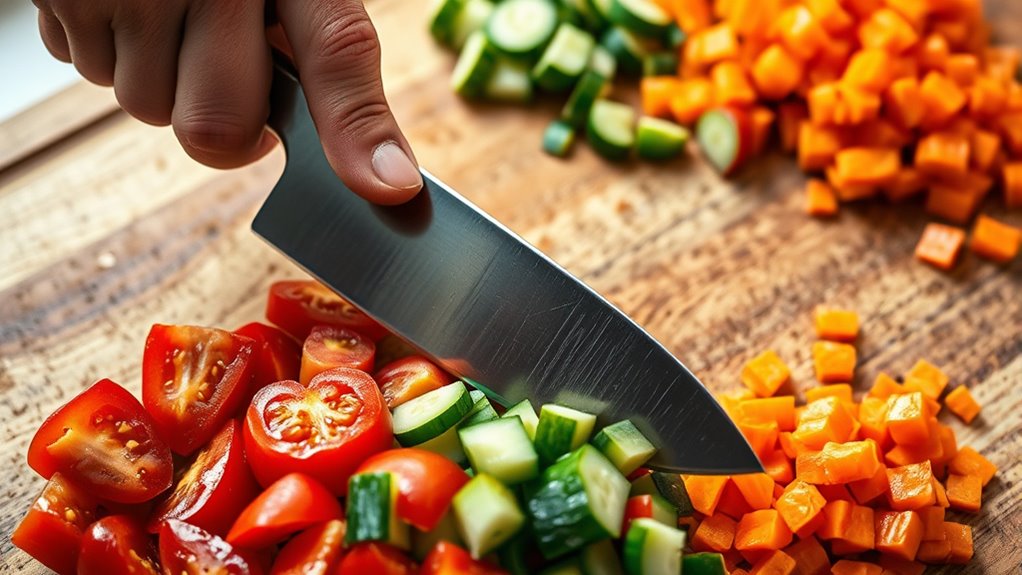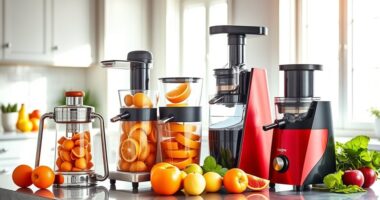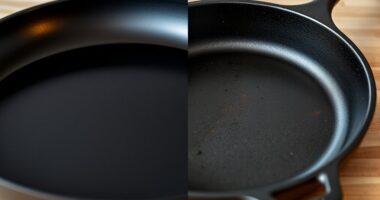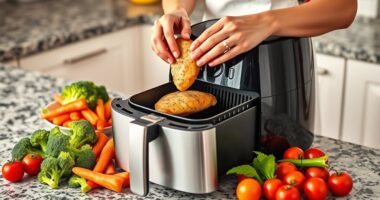To start with knife skills, choose a sturdy, comfortable knife like a chef’s knife with a good handle. Use a proper grip, curling your fingers inward and guiding the blade with controlled, smooth motions. Keep your knife sharp, handle it safely, and always cut on a stable surface. Practice basic techniques like slicing, dicing, and julienne while maintaining focus on safety. Keep going, and you’ll discover more tips to sharpen your abilities further.
Key Takeaways
- Choose a durable, comfortable chef’s knife with a stainless steel blade for easy handling and maintenance.
- Use proper hand positioning: grip the handle firmly, curl fingers inward, and tuck fingertips to prevent cuts.
- Practice controlled, rocking motions and let the knife’s weight do the work for precise cuts.
- Keep knives sharp and well-maintained with regular honing and sharpening for safety and efficiency.
- Store knives properly in a magnetic strip or knife block to prevent accidents and maintain blade integrity.
Choosing the Right Knife for Beginners
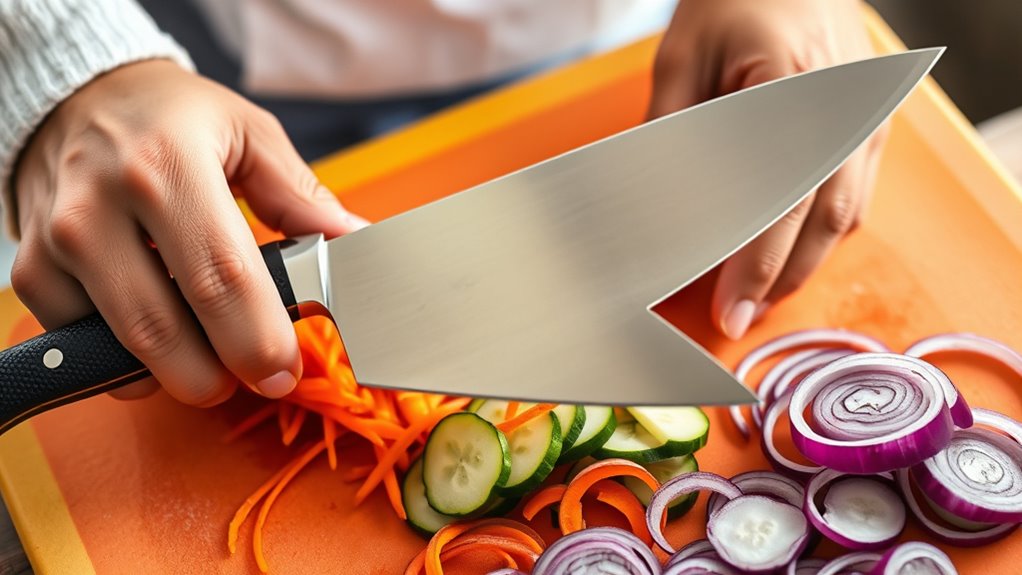
When starting out, choosing the right knife can make all the difference in building your confidence and developing proper technique. Focus on knife material, as stainless steel blades are durable and easy to maintain, making them ideal for beginners. Look for a knife with handle ergonomics that feel comfortable in your hand, providing a secure grip without causing fatigue. A well-designed handle reduces strain and improves control, essential for precise cuts. Avoid knives with overly complex designs or materials that feel slippery or uncomfortable. Keep your choice simple: a versatile chef’s knife with a balanced weight and comfortable handle will serve you well as you learn basic skills. Remember, the right combination of knife material and handle ergonomics can set a solid foundation for safe and effective cutting. Additionally, selecting appropriate knife types can enhance your overall cooking experience and help you master various techniques more effectively. To ensure longevity and consistent performance, choosing a high-quality blade is also highly recommended. Incorporating ergonomic handle design can further improve comfort during extended use, especially as you develop your skills. Moreover, understanding knife safety practices is crucial to prevent accidents and build confidence in your cutting techniques.
Basic Knife Safety Tips
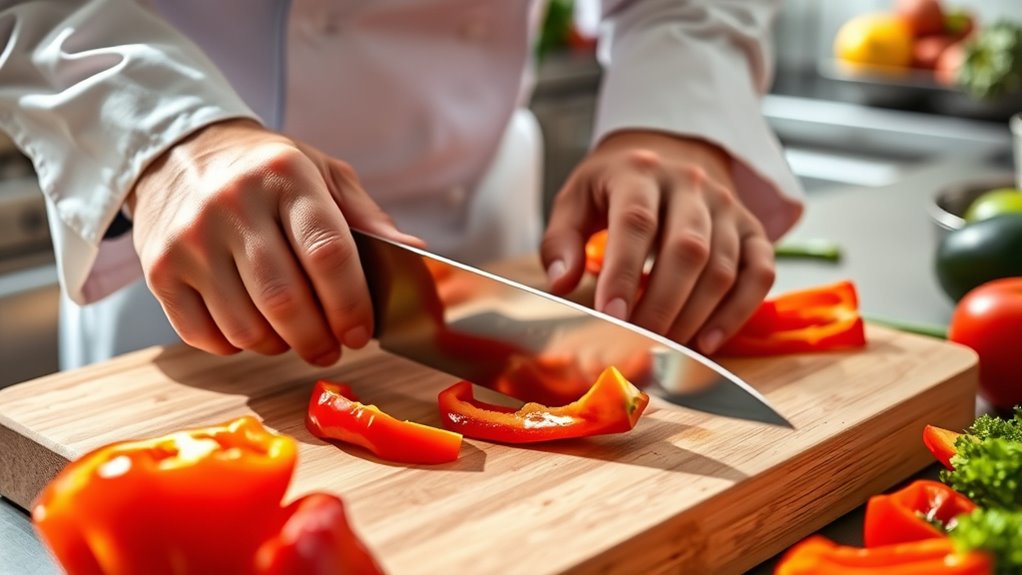
To stay safe in the kitchen, always handle knives with care and attention. Knife safety is essential to prevent accidents and injuries. When handling knives, keep your fingers tucked away from the blade and use a firm grip to maintain control. Never try to catch a falling knife; instead, step back and let it fall. Store knives properly in a knife block or on magnetic strips to avoid accidental cuts. Keep your knives sharp, as dull blades require more force and are more likely to slip. Always cut on a stable surface, like a cutting board, and pay close attention to what you’re doing. Proper blade maintenance not only extends the life of your knives but also enhances safety by reducing the risk of slips. Maintaining proper technique can further reduce the risk of accidents while cutting. Being aware of essential oils for safety can also help in emergency situations, such as minor cuts or burns. Following these handling tips helps guarantee your safety while preparing meals. Cultivating curiosity about proper techniques can also enhance your confidence and skills in the kitchen.
Proper Knife Grip and Handling
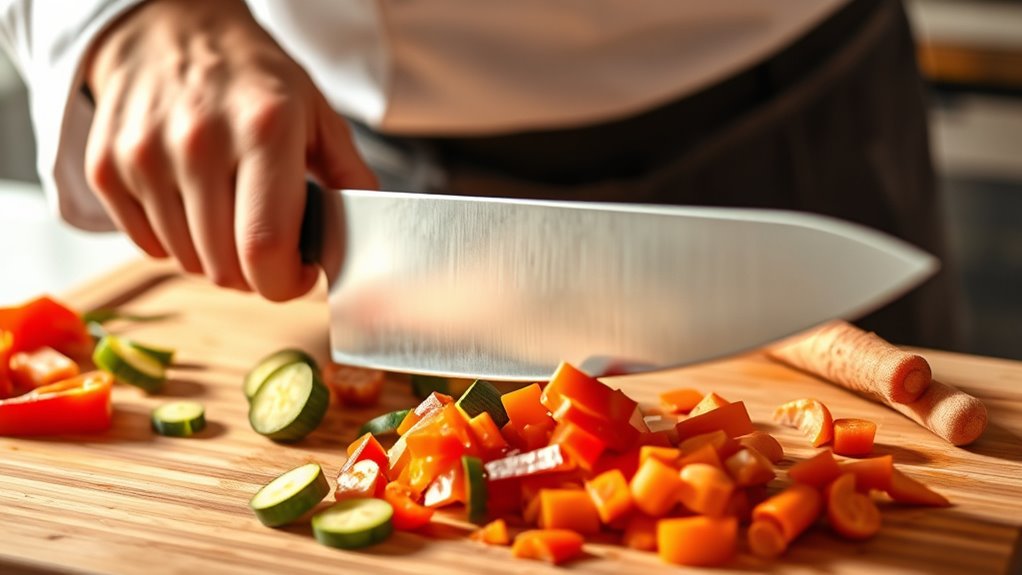
To handle your knife safely, you need to use the correct hand placement, gripping it firmly but not too tight. Maintaining control is key to making precise cuts and avoiding accidents. By practicing safe cutting techniques, you’ll become more confident and efficient in the kitchen. Additionally, understanding best practices for knife handling can further improve your safety and technique.
Correct Hand Placement
Have you ever wondered if you’re holding your knife correctly? Proper hand placement is key to safe, efficient cutting. Start with a confident knife grip, gripping the handle firmly but comfortably. Your fingers should wrap around the handle, with your thumb resting along the side for control. Focus on your finger placement: your index finger can rest along the blade’s spine or curl around the handle, depending on your comfort. Keep your other fingers curled inward on the food, guiding the knife while protecting your fingertips. Maintaining this hand position ensures better control and reduces the risk of slips. Using the proper knife skills can also improve overall efficiency and safety in your kitchen. Additionally, practicing correct technique helps prevent fatigue and injuries during extended prep sessions. Remember, developing proper cutting techniques is essential for both safety and precision.
Maintaining Knife Control
Maintaining control of your knife starts with a proper grip that keeps the tool steady and responsive. Your knife grip should be firm but relaxed, allowing smooth movements without tension. Hold the handle comfortably, avoiding a death grip that can hinder precision. A secure grip helps you maintain a consistent cutting rhythm, which improves accuracy and reduces fatigue. Focus on keeping your fingers close to the blade’s base, guiding the knife with controlled, deliberate motions. As you develop your technique, your cutting rhythm will become more natural, making slicing and chopping more efficient. Remember, a good knife grip isn’t just about control—it’s about maintaining stability throughout each cut while staying relaxed enough to move fluidly. Proper handling sets the foundation for safe and effective knife skills. Incorporating mindful practice can also enhance your overall knife technique in the kitchen, helping you experiment with new techniques and recipes. Developing awareness of proper knife grip techniques is essential for preventing accidents and building confidence in your skills. Additionally, understanding cutting mechanics can further improve precision and reduce strain during extended use.
Safe Cutting Techniques
A proper knife grip and handling form the foundation of safe cutting techniques. When you hold your knife correctly, you maintain better control and reduce the risk of accidents. Keep your grip firm but relaxed, with your index finger and thumb gripping the blade’s base, while your remaining fingers wrap around the handle. Always pay attention to your cutting surface to guarantee stability and prevent slips. Good knife safety also involves positioning your fingers away from the blade’s edge, so you avoid cuts. Visualize these points:
- Rest your cutting surface on a non-slip mat or damp cloth for stability.
- Keep your fingertips curled inward, guiding the knife with your knuckles.
- Use a controlled, rocking motion for precision and safety.
- Incorporating proper knife handling techniques can significantly improve your safety and efficiency in the kitchen.
- Being aware of cutting safety tips ensures you develop good habits that prevent injuries over time.
- Additionally, understanding home security systems can help protect your kitchen and home environment from theft or intrusion.
- Familiarizing yourself with state tax implications for IRA withdrawals helps in planning your retirement savings more effectively.
Essential Cutting Techniques: Slicing, Dicing, and Julienne

To master slicing, dicing, and julienne, you need to focus on proper hand positioning and controlled movements. Keeping your fingers tucked and steady guarantees safety and precision with each cut. Consistently maintaining the right slice thickness makes your dishes look professional and cook evenly. Creating a calm and organized workspace can also enhance your farmhouse bedroom ambiance by minimizing distractions and promoting focus on your technique.
Proper Hand Positioning
Proper hand positioning is essential for safe and efficient cutting, especially when mastering techniques like slicing, dicing, and julienne. You should hold the knife with a firm yet comfortable knife grip, ensuring control without tension. Your finger positioning on the hand holding the food is equally important: curl your fingers inward, keeping your knuckles facing the blade as a guide. This protects your fingertips from accidental cuts. Maintain a stable, relaxed grip on the handle, and always keep your guiding hand steady. Visualize your fingers forming a claw shape to keep them tucked away from the blade’s edge. Focus on a balanced grip and precise finger placement to improve accuracy and safety during all your chopping tasks. Using the proper self-watering plant pots can help ensure your plants stay healthy and well-hydrated, just as proper hand technique promotes safe cutting. Incorporating cutting techniques with awareness of your hand positioning can further reduce the risk of injury and improve your overall knife skills. Additionally, understanding how divorce laws impact financial stability can help you plan better for post-divorce life.
Controlled Cutting Movements
Mastering controlled cutting movements is essential for achieving consistent and safe results when slicing, dicing, or julienning. Focus on precision control by making deliberate movements with your knife, avoiding rushed or jerky motions. Maintain a steady hand and use smooth, intentional strokes to guide the blade through your ingredients. This approach helps guarantee uniform cuts and reduces the risk of accidents. Keep your grip firm but relaxed, and let the weight of the knife do most of the work. Practice patience and develop muscle memory for each technique. Controlled movements not only improve the quality of your cuts but also boost your confidence in the kitchen. With consistent focus on deliberate actions, you’ll refine your skills and produce professional-looking results.
Consistent Slice Thickness
Achieving consistent slice thickness is essential for even cooking and professional presentation. When your slices are uniform, food cooks evenly, and dishes look more appealing. To maintain knife consistency, focus on steady hand movements and control. Use a guide, like your knuckles, to keep the slice thickness uniform as you cut. Practice slicing with deliberate, even pressure to develop muscle memory. Remember, small adjustments make a big difference in knife consistency. For perfect results, aim for slices that are the same width each time. This precision improves the overall quality of your dishes and boosts your confidence. With practice, maintaining consistent slice thickness becomes second nature, elevating your knife skills to a professional level. Incorporating proper storage solutions can also help keep your knives sharp and ready for precise cuts.
How to Use a Cutting Board Effectively
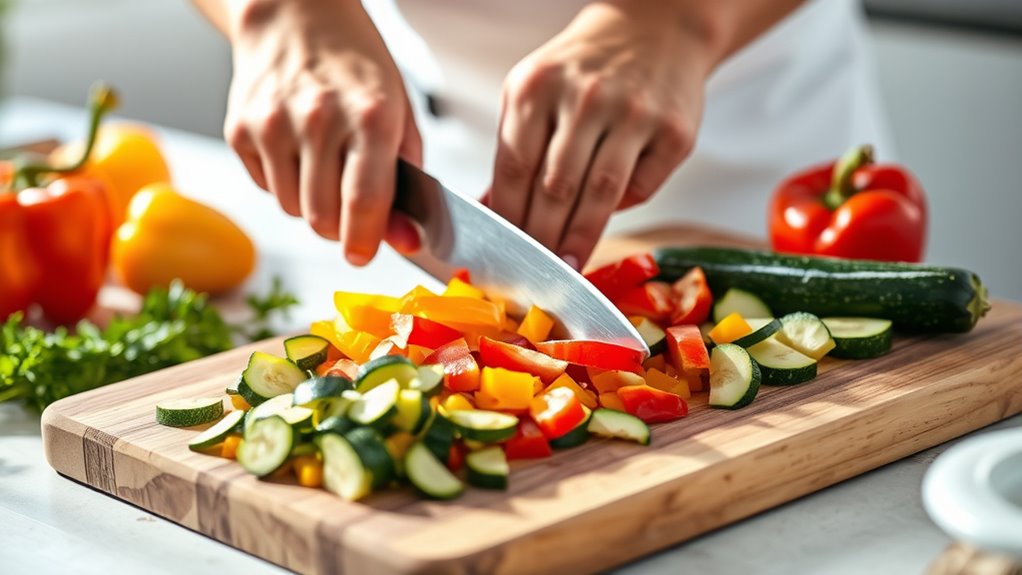
Using a cutting board effectively is essential for safe and efficient chopping. Begin by choosing the right surface—wood, plastic, or bamboo—based on your needs. Keep your cutting board clean and dry to prevent bacteria buildup; this is part of proper cutting board maintenance. Always use a damp cloth to wipe it down after use. When chopping, position the board securely on your countertop, using damp paper towels or a damp cloth underneath to prevent slipping. Store your knives properly to avoid damage and accidents—knife storage tips include using a knife block or magnetic strip. Avoid cutting on uneven or unstable surfaces, which can cause slips or injuries. Proper use of your cutting board creates a safer, more effective workspace and prolongs its lifespan. Additionally, selecting appropriate cleaning tools can help maintain your cutting board’s hygiene and longevity. Being aware of food safety practices related to cutting boards can further reduce the risk of cross-contamination.
Maintaining and Sharpening Your Knives
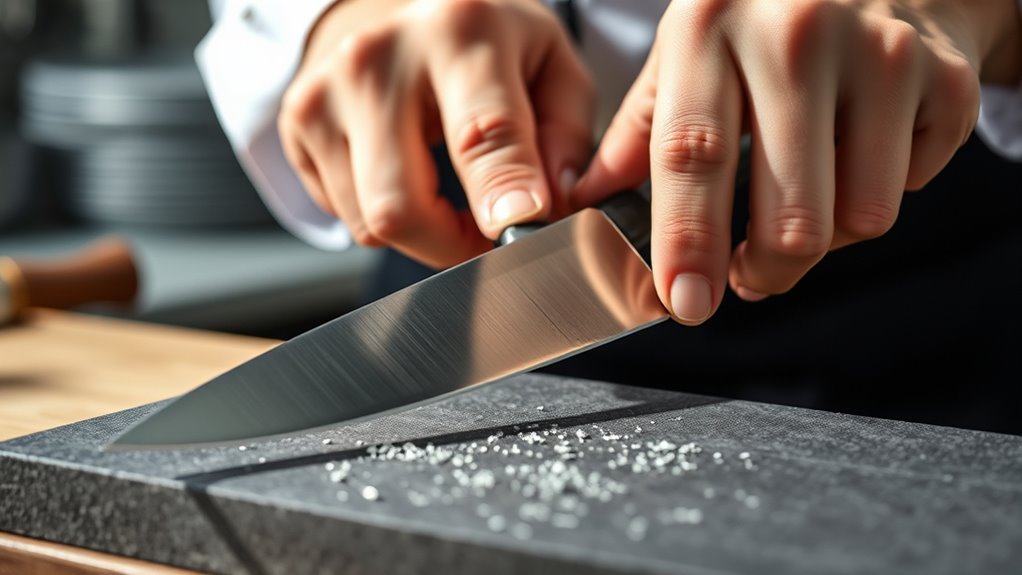
Regularly maintaining and sharpening your knives is essential to guarantee they perform safely and efficiently. Proper knife maintenance keeps blades in top shape, preventing accidents and making prep work easier. Sharpening techniques vary, but using a whetstone, honing rod, or electric sharpener can restore your knife’s edge effectively.
Keeping your knives sharp and well-maintained ensures safer, easier, and more efficient cooking.
- Visualize a razor-sharp blade slicing through vegetables with minimal effort
- Imagine a smooth honing rod aligning the edge for better performance
- Think of a well-maintained knife that feels confident and safe in your hand
Focusing on knife maintenance and sharpening techniques guarantees your knives stay sharp longer, reducing the need for frequent replacements. Keep your blades in prime condition for precise cuts and a safer, more enjoyable cooking experience.
Common Mistakes to Avoid When Using Knives
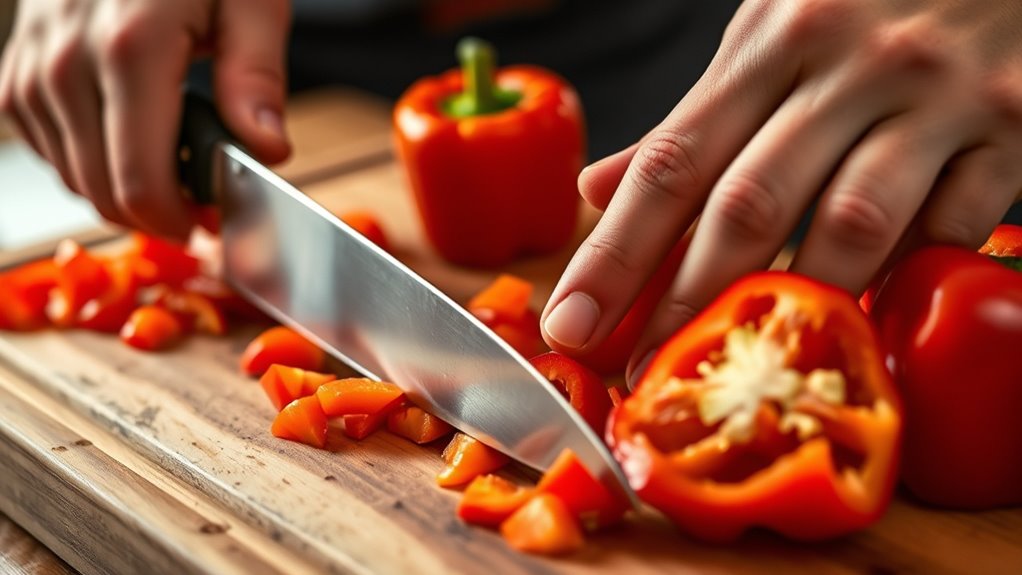
One common mistake to avoid is applying too much force when cutting, which can lead to slips and accidents. Relying on a dull edge instead of a sharp blade makes you press harder, increasing the risk of losing control. Always verify your knife has a sharp blade; a dull edge requires extra force and reduces precision. Instead, let the sharpness do the work, maintaining a steady, controlled motion. Avoid rushing or forcing the knife through ingredients, as this can cause uneven cuts and potential injuries. Proper technique involves using a smooth, slicing motion rather than brute strength. Regularly check your knife’s sharpness and hone it as needed. By respecting your knife’s sharpness and avoiding excessive force, you’ll cut safely and efficiently.
Practice Drills to Improve Your Knife Skills

Practicing specific drills can considerably enhance your knife skills and build confidence in the kitchen. Focus on precision practice to develop control and accuracy with each cut. Speed drills help improve your efficiency without sacrificing safety. To get started, try these exercises:
- Slice vegetables into uniform pieces, emphasizing consistent thickness and clean cuts.
- Complete timed chopping sessions, aiming to increase speed while maintaining precision.
- Practice julienne and dice techniques, gradually reducing your preparation time.
These drills sharpen your technique, boost your confidence, and make cooking more enjoyable. Remember, consistent practice is key—start slow, focus on control, then gradually increase speed. Incorporating both precision practice and speed drills into your routine will transform your knife skills over time.
Frequently Asked Questions
What Are the Best Knives for Small or Delicate Foods?
When working with small or delicate foods, you want knives that offer precision and control. A paring knife is ideal for these tasks, allowing you to perform delicate paring techniques with ease. Look for blades made from high-quality materials like stainless steel or ceramic, which stay sharp longer and offer better control. These knives help you handle intricate cuts confidently, making your work more accurate and enjoyable.
How Do I Choose the Right Knife for Different Cuisines?
Did you know that choosing the right knife can improve your cooking efficiency by up to 50%? When selecting a knife for different cuisines, consider the knife material—stainless steel offers durability, while high-carbon steel stays sharper longer. Also, look for ergonomic handles to reduce fatigue during long prep sessions. Different cuisines demand specific knives, so match your choice to your cooking style and comfort to make prep easier and more enjoyable.
Can I Use Household Knives for Professional Cooking?
You can use household knives for professional cooking, but it’s not ideal. For kitchen safety and knife maintenance, specialized chef’s knives are better—they’re sharper, more comfortable, and designed for precision. Using the right tools minimizes accidents and improves efficiency. Regularly sharpen and clean your knives to keep them in top condition. While household knives work temporarily, investing in quality professional knives ensures better safety, longevity, and cooking results.
How Often Should I Sharpen My Knives?
You might worry about how often to sharpen your knives, but regular maintenance makes a big difference. Typically, sharpen your knives every 1-2 months, depending on use. Using proper sharpening techniques, like honing before each use and honing steels, keeps your blades sharp longer. Remember, dull knives are more dangerous and less efficient. Consistent knife maintenance guarantees safety and precision, making your cooking experience more enjoyable and less frustrating.
What Are Signs My Knife Needs Replacement?
When you notice your knife isn’t cutting smoothly or requires more force, it’s time to consider replacing it. Dull blades compromise safety precautions because they increase the risk of slips and injuries. Regular blade maintenance helps extend its lifespan, but if it’s chipped, bent, or won’t hold an edge despite sharpening, replacing the knife ensures you maintain safety and efficiency in your kitchen. Always prioritize safety precautions during use and maintenance.
Conclusion
Mastering knife skills takes patience and practice, but it’s worth it—like honing the edge of Excalibur. Keep safety in mind, stay sharp, and don’t rush your progress. With each chop and slice, you’ll gain confidence in your abilities, transforming your kitchen into your personal round table. Remember, even the greatest chefs started with simple cuts. So, grab your knife and create culinary magic—your journey to becoming a kitchen knight begins now.
